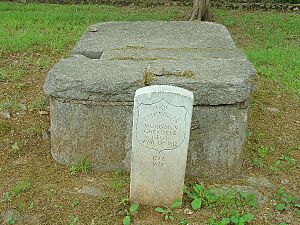Pathkiller facts for kids
Quick facts for kids
Pathkiller
|
|
|---|---|
| Cherokee Nation Principal Chief | |
| In office 1811 – January 8, 1827 |
|
| Preceded by | Black Fox |
| Succeeded by | Charles Hicks |
| Personal details | |
| Died | January 8, 1827 New Echota, Georgia |
| Known for | Last full-blooded national Cherokee chief |
Pathkiller (died January 8, 1827) was a respected Cherokee warrior and an important leader. He served as the Principal Chief of the Cherokee Nation. He is known as the last chief whose position was passed down through his family.
Contents
Pathkiller: A Cherokee Leader
Pathkiller was a significant figure in Cherokee history. He lived during a time of great change for his people. He was known for his bravery as a warrior and his leadership as a chief.
Early Life and Warrior Days
Pathkiller was a strong warrior who fought to protect his people and their lands. He took part in battles against American settlers. These settlers were moving into Cherokee territory, especially during the American Revolutionary War.
He joined forces with Dragging Canoe and the Chickamauga Cherokee. This group fought in the Cherokee–American wars until 1794. Later, Pathkiller might have served as a colonel with the Tennessee militia. He may have fought with Colonel Gideon Morgan under Andrew Jackson. This was during the Creek War (1813–1814), which was connected to the War of 1812.
Becoming Principal Chief
Pathkiller became the Principal Chief of the Cherokee Nation in 1811. He held this important position until his death in 1827. He was the last chief whose leadership was considered hereditary, meaning it was passed down through his family line.
In 1818, a missionary named Ard Hoyt visited the Cherokee government. He described Pathkiller as a "venerable looking man" who was 73 years old. Pathkiller sat on a rug, while other chiefs sat in chairs around him. This shows how respected he was.

After 1813, much of the real power in the Cherokee Nation shifted. This power went to Charles R. Hicks, who was the first chief of partial European descent. Pathkiller remained chief in title, but he was more of a figurehead. This means he was still the official leader, but Charles Hicks made many of the decisions.
Pathkiller passed away on January 8, 1827. Just two weeks later, Charles Hicks also died. This created a gap in leadership. William Hicks, Charles's brother, stepped in temporarily. Pathkiller and the Hicks family were important mentors to John Ross. They saw that Ross, a young Cherokee of Scots-Irish descent, had great potential. After the Cherokee Nation formed a new government, John Ross was elected Principal Chief in October 1828.
Pathkiller's Burial Site
There is a monument-style tomb that is believed to be Pathkiller's burial site. It is located near present-day Calhoun, Georgia. This area was once New Echota, the capital city of the Cherokee Nation. The tomb was previously known as the burial site of an "unknown Indian."

